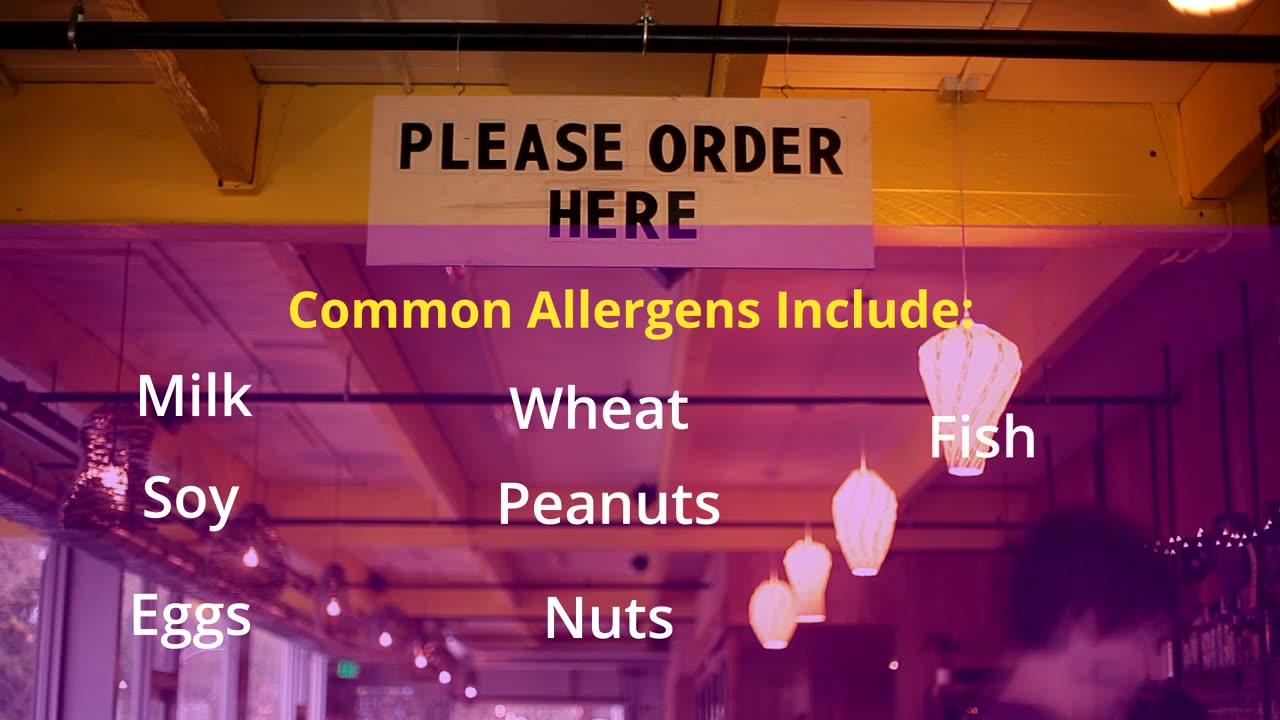Premium Only Content

eFoodHandlers presents- Allergies and Communication
### **eFoodHandlers Presents: Allergies and Communication**
---
Food allergies are a serious concern in foodservice, as they can lead to severe or life-threatening reactions. Understanding how to handle allergens and communicate effectively with customers and staff is essential for maintaining food safety and ensuring customer trust.
---
### **Understanding Food Allergies**
A food allergy is an immune system reaction to specific proteins in food. Even trace amounts can trigger a reaction in sensitive individuals.
#### **Common Symptoms of an Allergic Reaction:**
- Itching or swelling in the mouth or throat.
- Hives, rash, or swelling of the face, lips, or tongue.
- Difficulty breathing or wheezing.
- Stomach cramps, vomiting, or diarrhea.
- Severe reactions can lead to **anaphylaxis**, a life-threatening condition requiring immediate medical attention.
---
### **The Big 9 Food Allergens**
In the United States, the most common allergens are:
1. Milk
2. Eggs
3. Fish (e.g., salmon, cod)
4. Shellfish (e.g., shrimp, crab, lobster)
5. Tree nuts (e.g., almonds, walnuts, pecans)
6. Peanuts
7. Wheat
8. Soy
9. Sesame
These account for the majority of food allergy reactions.
---
### **Preventing Cross-Contact**
Cross-contact occurs when allergens transfer from one food or surface to another, potentially contaminating allergen-free foods. To prevent cross-contact:
1. **Separate Equipment and Utensils:**
- Use dedicated cutting boards, knives, and cookware for allergen-free foods.
- Label or color-code allergen-specific tools.
2. **Thorough Cleaning:**
- Wash hands, utensils, and surfaces with hot, soapy water after handling allergens.
- Sanitize equipment before preparing allergen-free orders.
3. **Avoid Shared Cooking Spaces:**
- Cook allergen-free items separately from allergen-containing foods.
- Use separate fryers, grills, or pans if possible.
4. **Proper Storage:**
- Store allergens in clearly labeled containers, away from non-allergen items.
- Prevent accidental spills or contamination in storage areas.
---
### **Communicating About Allergies**
#### **With Customers:**
- **Ask Questions:**
- Always ask if anyone in the party has food allergies before taking an order.
- **Be Honest:**
- If you cannot guarantee an allergen-free meal, inform the customer.
- **Know the Menu:**
- Be aware of ingredients in dishes and potential allergens.
- Confirm with the kitchen staff if unsure about specific items.
- **Use Allergen Notices:**
- Provide clear allergen information on menus, signs, or packaging.
#### **With Kitchen Staff:**
- **Mark Allergies Clearly:**
- Use special notes or tags for allergen-free orders.
- **Educate Team Members:**
- Train staff on the importance of allergen safety and protocols.
- **Communicate Changes:**
- Inform staff of recipe modifications or new allergens in ingredients.
---
### **What to Do in an Emergency**
1. **Recognize Symptoms:** If a customer shows signs of an allergic reaction, act quickly.
2. **Alert Emergency Services:** Call 911 if anaphylaxis is suspected.
3. **Use an Epinephrine Auto-Injector:** If available, administer as directed and stay with the customer until help arrives.
4. **Document the Incident:** Record what happened for follow-up and review procedures to prevent future incidents.
---
### **Building Trust with Customers**
By being proactive about allergen safety and transparent in communication, foodservice workers can create a safe and inclusive dining experience for all customers.
If you’d like additional tips or resources, let me know!
-
 20:24
20:24
HSESafetyInformation
6 months agoKABULI PULAO RECIPE - Original 40+ KG Afghani Meat Pulau Prepared - Street Food Qabili Plav Recipe_2
35 -
 LIVE
LIVE
The Pete Santilli Show
2 hours agoMORNING STREAM Tuesday September 9, 2025 💣 THE PETE SANTILLI SHOW & SANTILLI REPORT (Monday 9/8)
500 watching -
 LIVE
LIVE
The Chris Salcedo Show
11 hours agoWhat Does The Data & Science Say?
451 watching -
 20:14
20:14
Jasmin Laine
17 hours agoSHOCKING SLIP-UP: Liberals Accidentally CONFIRM Oil & Gas PHASE-OUT
35.1K23 -
 38:14
38:14
The Official Corbett Report Rumble Channel
1 day agoWar Is A Crime
10.6K21 -
 LIVE
LIVE
BEK TV
23 hours agoTrent Loos in the Morning - 9/09/2025
241 watching -
 LIVE
LIVE
The Bubba Army
22 hours agoMore Epstein Files Dropped! - Bubba the Love Sponge® Show | 9/09/25
2,185 watching -
 LIVE
LIVE
FyrBorne
19 hours ago🔴Warzone M&K Sniping: How To Harness The Beast (Of Sniping)
108 watching -
 7:02
7:02
Sugar Spun Run
1 day ago $1.37 earnedBrownies from Scratch
32.9K6 -
 10:07
10:07
The Official Steve Harvey
16 hours ago $0.72 earned82 Years of Love, Laughs & Keeping It Real
11.6K1